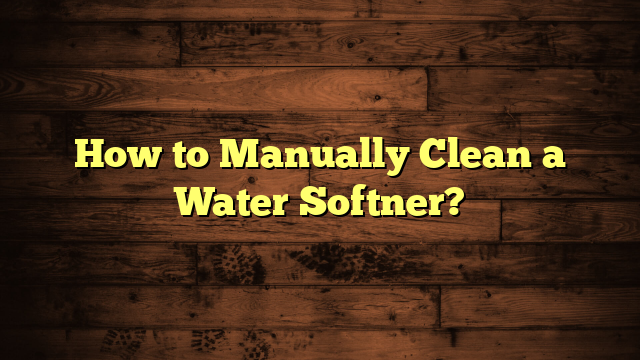How to Manually Clean a Water Softner?
Isn't it interesting how a little maintenance can extend the life of your water softener? To manually clean it, you'll need to gather some essential supplies and take a systematic approach. First, you'll turn off the water supply and drain the unit, but what comes next could make all the difference in its performance. By understanding the critical steps involved, you'll guarantee your system runs efficiently and effectively. So, what's the best way to tackle the cleaning process?
Key Takeaways
- Gather necessary supplies including a specialized cleaner, gloves, sponge, and bucket for effective cleaning.
- Turn off the water supply by locating and closing the main shut-off valve to prevent leaks.
- Drain the water softener by using buckets to collect water and directing it away from your home.
- Clean the brine tank by removing salt and debris, scrubbing with a vinegar solution, and rinsing thoroughly.
- Inspect all components for wear before reassembling, ensuring all seals are secure to prevent leaks.
Gather Necessary Supplies
What do you need to gather before diving into cleaning your water softener? Start with a supplies checklist to make sure you've got everything on hand.
First, you'll need a suitable cleaning agent, often a specialized resin cleaner or vinegar. These cleaning agents help break down any buildup within the system.
Next, grab a bucket to collect any residual water that may spill out during the cleaning process. A garden hose can come in handy for rinsing, too, so don't forget it.
You might also want a pair of rubber gloves; they'll protect your hands from any harsh chemicals.
Additionally, have a sponge or cloth ready for wiping surfaces and a brush for scrubbing hard-to-reach areas. If you've got a vacuum or a shop vac, it can be useful for removing debris.
Lastly, consider having a timer or a notebook to track your cleaning schedule. Keeping records helps you maintain your softener effectively.
With all these supplies gathered, you'll be prepared to tackle the cleaning process with confidence, ensuring your water softener runs smoothly for years to come.
Turn Off the Water Supply
Before you start cleaning your water softener, it's important to turn off the water supply. This step is vital to prevent any unwanted water flow while you work.
To do this, locate the main shut-off valve, which is typically near the water softener unit. Once you've found it, turn the valve clockwise until it's fully closed. This simple action guarantees that no water enters the system during your cleaning process, making everything safer and more efficient.
Here's a quick checklist to guide you:
- Identify the main shut-off valve.
- Turn the valve clockwise to shut it off.
- Check for any leaks around the valve.
- Confirm the water softener display is off.
- Keep the valve closed until you've completed the cleaning.
Drain the Water Softener
Now that you've turned off the water supply, it's time to drain your water softener.
Start by preparing for the draining process, making sure you have a suitable container for the water.
Prepare for Draining Process
When you're ready to drain your water softener, it's essential to prepare properly to avoid any mess. Having a solid game plan in place guarantees you use effective drainage techniques and minimizes potential spills.
Start by gathering the necessary supplies, so you're not scrambling later.
Here's a helpful preparation checklist:
- Buckets or containers: To collect the water from the softener.
- Garden hose: For directing water away from your home.
- Towels or rags: To clean up any spills that may occur.
- Gloves: To protect your hands from any chemicals or residue.
- Safety goggles: To shield your eyes from splashes.
Thorough preparation makes the draining process smoother and more efficient.
Before you begin, verify that all connections are secure and that you know where the water will drain. This mindful approach not only keeps your work area tidy but also helps you avoid any unnecessary complications later on.
Proper Disposal of Water
With your supplies ready and the area prepared, you can start the process of draining the water softener. Proper disposal is essential not just for water quality but also for minimizing environmental impact. When you drain your water softener, make sure the discharge doesn't contaminate nearby water sources. Here's a simple table to help you understand the options for disposing of the water:
| Disposal Method | Water Quality Impact | Environmental Impact |
|---|---|---|
| Drain into a sewer system | Generally safe | Low, if properly connected |
| Direct to a garden | Can improve soil quality | Risk of salt build-up |
| Local disposal regulations | Must follow guidelines | Varies by local ordinance |
Before you begin, check local regulations about where to drain the water. Always avoid draining into storm drains or open bodies of water, as this can negatively affect local ecosystems. By following these guidelines, you'll guarantee that your water softener is drained responsibly, maintaining water quality and protecting the environment. Remember, taking the right steps in disposal helps preserve our natural resources for future generations.
Remove the Brine Tank Cover
Before you remove the brine tank cover, it's essential to take some safety precautions.
Make sure you have the right tools on hand, as this will make the process smoother and more efficient.
Once you're prepared, you'll be ready to get started on cleaning your water softener.
Safety Precautions First
Safety is paramount when cleaning your water softener, especially as you prepare to remove the brine tank cover.
You need to take proper precautions to guard against potential risks, including chemical hazards associated with the salt and cleaning solutions used in the water softener.
Before diving in, make certain you're equipped with the right safety gear to protect yourself.
Here are some essential safety precautions to keep in mind:
- Wear gloves: Protect your hands from chemical exposure.
- Use goggles: Shield your eyes from splashes and irritants.
- Work in a well-ventilated area: Confirm good airflow to avoid inhaling harmful fumes.
- Keep children and pets away: Create a safe workspace by keeping distractions at bay.
- Have a first aid kit nearby: Be prepared for any accidents or injuries.
Tools Needed for Removal
Now that you're prepared and protected, it's time to gather the tools you'll need to remove the brine tank cover. This process requires some essential equipment to make your task easier and more efficient. Here's a list of tool types you'll want to have on hand.
| Tool Type | Purpose |
|---|---|
| Screwdriver | To remove screws holding the cover |
| Pliers | For gripping and twisting parts |
| Bucket | To catch any spills |
| Towels | For cleanup |
| Flashlight | To illuminate dark areas |
Make sure you have a screwdriver that fits the screws on your brine tank cover, as some may require a Phillips or flathead. Pliers will help you if any stubborn parts need extra grip. A bucket is handy for catching any residual brine or water that could spill out during removal. Keep some towels nearby for quick cleanup. Finally, a flashlight is great for checking any hidden areas or examining the tank's condition. With these tools at your side, you're ready to tackle the brine tank cover removal efficiently!
Clean the Brine Tank
How often do you think about cleaning the brine tank in your water softener? If you're like most people, it's probably not at the top of your to-do list.
However, regular brine tank maintenance is essential for the efficiency of your system. A clean brine tank guarantees that your salt level remains ideal, preventing issues that could affect your water quality.
To clean the brine tank effectively, follow these steps:
- Turn off the water softener to prevent any accidental cycling.
- Remove any remaining salt and debris from the tank.
- Scrub the tank's interior with a mixture of warm water and vinegar to eliminate any buildup.
- Rinse thoroughly to confirm no cleaning solution remains.
- Inspect the float assembly for any signs of wear or damage.
Once you've completed these steps, refill the tank with fresh salt to maintain the right salt level.
By keeping your brine tank clean, you'll extend the life of your water softener and improve its performance. Regular cleaning not only enhances functionality but also saves you money in the long run.
Don't overlook this important task!
Rinse and Reassemble Components
After cleaning your brine tank, it's crucial to rinse and reassemble the components to verify everything functions smoothly.
Begin by taking the time to rinse components thoroughly. This step guarantees that no cleaning residues remain, which could interfere with the water softener's performance. Use a garden hose or bucket to rinse out any remaining salt or debris from the tank and other parts you've cleaned.
Once you've rinsed all the components, inspect them for any signs of wear or damage. If you notice anything concerning, it may be best to replace those parts before reassembling.
Next, carefully reassemble parts in the reverse order of disassembly. Make sure each piece fits snugly and securely to avoid leaks or malfunctions later on.
When reassembling, double-check your work. It's easy to overlook a small detail, but even minor oversights can lead to bigger issues down the road.
Finally, verify that all seals are properly positioned, and tighten any screws or bolts as needed. Taking these steps will help maintain your water softener's efficiency, confirming it continues to provide you with soft water for your home.
Restore Water Supply and Test
Once you've reassembled your water softener, it's time to restore the water supply and test the system. Start by turning the water supply back on, and check for any leaks around the fittings.
It's essential to guarantee everything is secure and functioning properly. Next, run the water for a few minutes to flush out any debris that may have settled during cleaning.
Now, let's focus on water quality. You'll want to perform some testing procedures to confirm your water softener is working effectively.
Here's a quick list of what to do:
- Check the hardness level using a water test kit.
- Inspect for any unusual odors or colors in the water.
- Monitor the flow rate to confirm it's consistent.
- Test for salt content to verify proper regeneration.
- Look for any signs of scale buildup in faucets or appliances.
After completing these steps, you'll have a clear picture of your water quality and the effectiveness of your water softener.
If issues arise, don't hesitate to consult the manufacturer's manual or seek professional help.
Frequently Asked Questions
How Often Should I Clean My Water Softener?
You should check your water softener's cleaning frequency based on usage and manufacturer recommendations. Following a regular maintenance schedule helps guarantee peak performance, so don't forget to keep an eye on it periodically.
What Type of Cleaner Is Safe for My Brine Tank?
Cleaning your brine tank's like giving it a revitalizing spa day! For safe cleaners, stick to vinegar or a specialized water softener cleaner. They'll keep everything sparkling without damaging your system. Enjoy the process!
Can I Use Vinegar to Clean the Water Softener?
You can use vinegar to clean your water softener, as it offers benefits like removing buildup. However, consider other cleaning alternatives too, ensuring you maintain efficiency and prevent any potential damage to your system.
What Are Signs That My Water Softener Needs Cleaning?
"An ounce of prevention is worth a pound of cure." If you notice cloudy water, scaling, or unusual tastes, these signs indicate your water softener needs cleaning. Regular maintenance tips can help guarantee ideal water quality.
Is It Necessary to Service the Water Softener Regularly?
Yes, servicing your water softener regularly is essential. It guarantees ideal water quality and extends the system's lifespan. Stick to a maintenance schedule to prevent issues and keep your water softener functioning efficiently.
Conclusion
By following these steps, you can effectively clean your water softener and maintain its efficiency. Did you know that a well-maintained water softener can reduce scale buildup by up to 75%? Regular cleaning not only prolongs the life of your system but also enhances your water quality. So, take the time to care for your water softener; it'll pay off in cleaner water and improved appliance longevity. Happy cleaning!







